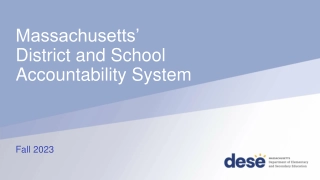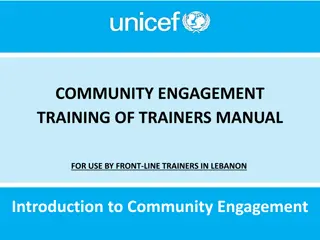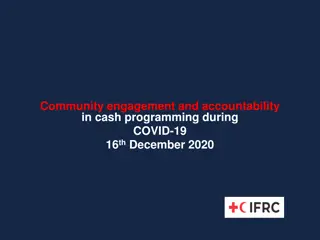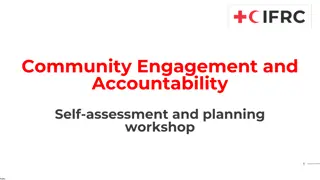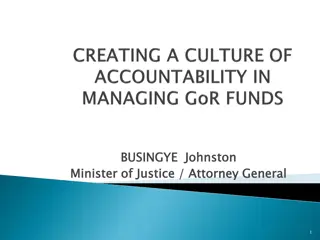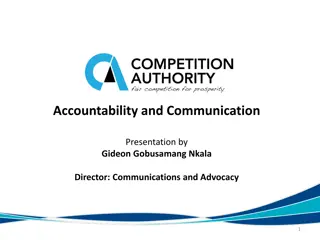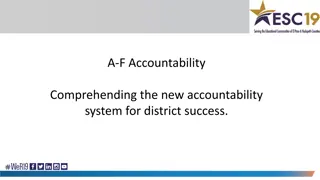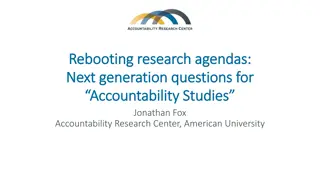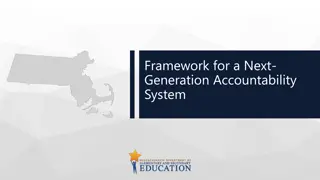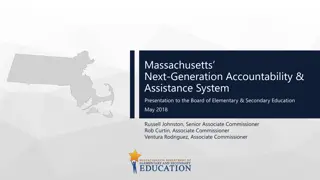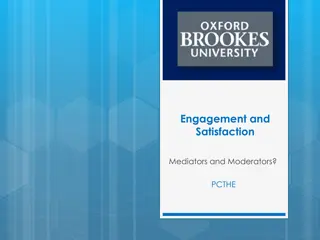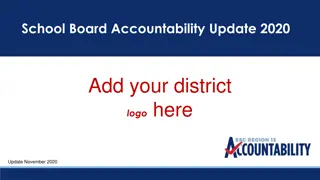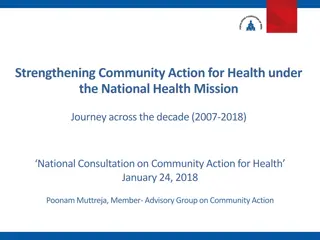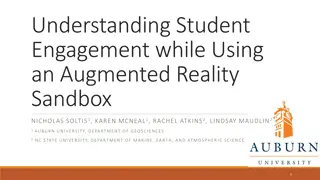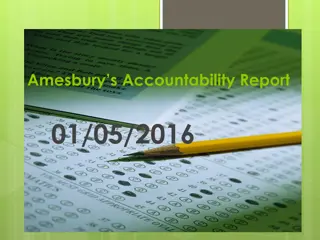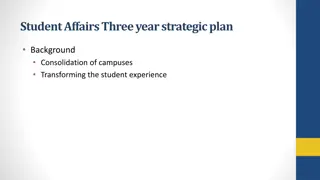Key Factors in the HB5 Community and Student Engagement Accountability System
The HB5 system evaluates school districts based on nine factors including fine arts, wellness, community involvement, workforce development, second language acquisition, digital learning, dropout prevention, gifted programs, and compliance. Working committees focus on areas like fine arts, wellness, community involvement, workforce development, and language programs, with designated chairs leading each focus area. The system emphasizes district and campus performance ratings in different evaluation factors to ensure overall effectiveness and compliance.
Download Presentation

Please find below an Image/Link to download the presentation.
The content on the website is provided AS IS for your information and personal use only. It may not be sold, licensed, or shared on other websites without obtaining consent from the author. Download presentation by click this link. If you encounter any issues during the download, it is possible that the publisher has removed the file from their server.
E N D
Presentation Transcript
HB5 Community and Student Engagement Accountability System Key Communicators April 24, 2014
Nine Factors: HB 5 Sec. 39.0545 1. Fine Arts 2. Wellness and P.E. 3. Community and Parental Involvement 4. 21st Century Workforce Development Program 5. Second Language Acquisition Program 6. Digital Learning Environment 7. Dropout Prevention Strategies 8. Educational Programs for Gifted and Talented Students 9. Record of District and Campus Compliance with Statutory Reporting and Policy Requirements Each school district shall evaluate the district's performance and the performance of each campus and assign the district and each campus a performance rating of exemplary, recognized, acceptable, or unacceptable for both overall performance and each individual evaluation factor.
CSEAS Working Committees CSEAS Factors Central Staff Principals Fine Arts Kathy Kuddes (Chair) Fine Arts Janice Truit Visual Arts Jeff Turner Instrumental Music Greg Arp Theatre Arts/Speech Susan Hayes Special Assignments Billie-Jean Lee Robinson George King Plano East Jill Stoker Mathews Cindy Savant Rose Haggar Sandy Muzquiz Meadows Wellness and P.E. Melinda Smith (Chair) P.E./Health Mary Swinton Elementary Science Brant Perry Murphy Kary Cooper Jasper Katie Babb Aldridge Lynn Swanson Thomas Renee Rucker Mitchell
CSEAS Working Committees CSEAS Factors Central Staff Principals Community and Parental Involvement Mary Gorden (Chair) Communications Gail Lundberg Special Education Joanna Chandler Federal Programs Robin Garcia Campus Support Lynda Shuttlesworth Family Education and Guidance Services Kay Glawe Family and Social Services Rhonda Snyder, Plano ISD Council of PTAs Shurandia Holden Frankford Kathy King Plano West Mariea Sprott Hightower Jane Oestreich Hickey Michele Loper Barron 21st Century Workforce Development Program Lisa Long Hendrick Lynn Ojeda Williams Saul Laredo Dooley Sarika Pride Memorial Kellie Latimer Saigling David Hitt (Chair) Career and Technology Education Paul Weaver Guidance and Family Education Services
CSEAS Working Committees CSEAS Factors Central Staff Principals Greta Lundgaard (Chair) Languages Other than English Emelia Ahmed Multilingual Lisa Long Hendrick Lynn Ojeda Williams Saul Laredo Dooley Sarika Pride Memorial Kellie Latimer Saigling Chris Glasscock Rice Renee Godi Academy High Kristi Graham Hedgecoxe Cindy Guinn Daffron Toni Strickland Huffman Steve Ewing Armstrong Sarah Watkins Plano Senior Ben Benavides Weatherford Jeanne Beall Schell Second Language Acquisition Program Digital Learning Environment Harriet Bell (Chair) Instructional Tech Lisa Wellborn Elem. Social Studies Lisa Farrell Early Childhood Jean Parmer eSchool Dropout Prevention Strategies Gary Wilson (Chair) Section 504 Kim Edmonds ESL Laura Childress Bird Education Center Sharon Bradley Special Programs, Mike Landingham Student Services
CSEAS Working Committees CSEAS Factors Central Staff Principals Educational Programs for Gifted and Talented Students Theresa Biggs (Chair) Gifted Education Jason Myatt Schimelpfenig Janis Williams Clark Barbara Lange Brinker Linda Patrick Carlisle Tramy Tran Forman Compliance with Statutory Reporting and Policy Requirements Joana Sorrels (Chair) Accountability Emelia Ahmed Multilingual Gail Lundberg Special Education Mark Allen Student & Family Services Kathy Dry Student Records/PEIMS Antoine Spencer Otto Ann Irvine Harrington Project Manager Dr. Paul Dabbs Assessment & Accountability
Key Milestones September 23 CSEAS Launch Meeting by October 4 Committee Literature Review October 8 Central Staff Meeting: review drafts by November 21 Central Staff/Principals: draft diagnostics November 25 Proposal to District Committee December 4 Review diagnostics with all principals and assistant principals January 8 Final review by all principals January 14 Presentation to Board February 17 Campus level documents available April 9 Presentation and review of documents and procedures with all principals and assistant principals May 23 Campus evaluations completed, results posted to web-based system June 27 District-level evaluation complete August 8 District and campus ratings submitted to TEA
Programs for Gifted and Talented Students: Professional Development 1 3 5 Teachers serving gifted/talented students have not had the 30 hour state mandated gifted training. Teachers serving gifted/talented students have received the 30 hour state mandated gifted trainings and the 6 update hours. Teachers serving gifted/talented students have received the 30 hour state mandated gifted trainings and the 6 update hours. Administrators and counselors have received the minimum initial 6 hour gifted training. Administrators and counselors have received the minimum 6 hour gifted training and most of the administrators and counselors have received an annual 6 hour update.
Diagnostic Indicators for Evaluation CSEAS Factors Elementary Middle HS SHS Fine Arts 8 21 22 25 Wellness and P.E. 13 13 13 13 Community and Parental Involvement 16 16 16 16 21st Century Workforce Development Program Second Language Acquisition Program 5 4 6 7 4 9 8 11 Digital Learning Environment 7 7 7 7 Dropout Prevention Strategies 15 15 15 15 Educational Programs for Gifted and Talented Students Record of District and Campus Compliance with Statutory Reporting and Policy Requirements 6 6 5 5 13 13 13 13
Summarizing Diagnostic Indicators for a Rating Rating System (with 10 diagnostics) Performance Rating 9/10 Indicators 3 or Higher + At Least 1 Indicator Above 3 Exemplary 8/10 Indicators 3 or Higher + At Least 1 Indicator Above 3 Recognized Acceptable 7/10 Indicators 3 or Higher Unacceptable 4/10 or More Indicators Below 3
Example of Summary Report CSEAS Factors Rating Fine Arts Exemplary Wellness and P.E. Recognized Community and Parental Involvement Acceptable 21st Century Workforce Development Program Exemplary Second Language Acquisition Program Recognized Digital Learning Environment Exemplary Dropout Prevention Strategies Recognized Educational Programs for Gifted and Talented Exemplary Compliance with Statutory Reporting and Policy Recognized Overall Campus Evaluation Rating _____________
Overall Campus Evaluation Rating Campus From Factor Ratings Evaluation Rating All Factors are Acceptable/Met or Higher + 3/8 Factors Exemplary Exemplary All Factors are Acceptable/Met or Higher + 3/8 Factors Recognized or Higher Recognized Acceptable 8/9 Factors are Acceptable/Met or Higher Unacceptable Two or More Factors Not Acceptable/Not Met
Evaluation of Community and Student Engagement Accountability System DISTRICT LEVEL
District Level CSEAS Process Goal is to evaluate how well the district designs, supports, and continues improvements to programs that enable campuses to perform satisfactorily in all the program areas The key practices evaluated are: Leadership and Capacity Building Monitoring Performance and Progress Intervention and Adjustment
Programs for Gifted and Talented Students: Professional Development 1 3 5 District leaders do not establish a process to evaluate programs or strategies based on evidence of effectiveness and efficient use of resources. District leaders establish a process to evaluate programs or strategies based on limited evidence of effectiveness and efficient use of resources. District leaders establish a process to evaluate programs or strategies based on clear evidence of effectiveness and efficient use of resources.
CSEAS Schedule Campuses can begin using the diagnostic system to evaluate starting February 17 As most diagnostic indicators are on programs, implementation, and participation of students, this information is already available for evaluation Campuses will complete the diagnostics in June District diagnostic will be in June and will review campus diagnostic information as input August 8 Report data to TEA
CSEAS Schedule Campuses can begin using the diagnostic system to evaluate starting February 17 As most diagnostic indicators are on programs, implementation, and participation of students, this information is already available for evaluation Campuses will complete the diagnostics in June District diagnostic will be in June and will review campus diagnostic information as input August 8 Report data to TEA
HB5 Community and Student Engagement Accountability System Key Communicators April 24, 2014


